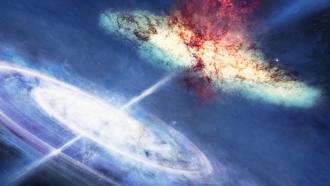![The Andromeda Galaxy, the nearest major galaxy to our own, the Milky Way. [Image Credits: Farmakopoulos Antonis] Molecular hydrogen making up galactic discs come in two forms](/sites/researchmatters/files/styles/large_800w_scale/public/m31_antonis_20021.jpg?itok=8mJOO9Bu)
The Andromeda Galaxy, the nearest major galaxy to our own, the Milky Way. [Image Credits: Farmakopoulos Antonis]
Galaxies like the one we reside in, the Milky Way, consist of discs containing stars, molecular and atomic hydrogen and helium. The molecular hydrogen gas collapses on itself in distinct pockets, forming stars, which are visible brightly in the visible parts of the electromagnetic spectrum. The atomic hydrogen extends both above and below the discs. The gravity of the atomic and molecular gases, the stars, and dark matter –– a component of matter whose constituents are yet unknown –– pull the galaxy inwards. On the other hand, the outward pressure exerted by these gaseous components counters the gravitational pull. The warmer the gas, the greater the outward pressure. Gravity and pressure balance to give rise to what astronomers call the ‘equilibrium’ –– the atomic and molecular gas or the stars neither collapse on themselves nor fly away into the cosmos.
The molecular and atomic gas emits electromagnetic waves at specific frequencies, which astronomers observe using telescopes. These ‘spectral lines’ tell them what exactly constitutes the gas in the region the telescope points to and the temperature of the constituent. They scan different parts of the sky with the telescopes and map out the temperatures of every region they scan. Astronomers have observed the molecular hydrogen gas over the years and found that it is cold, with temperatures around close to 10 kelvin, or -263 ºC. The thickness of the disc of the cold molecular hydrogen gas is about 60 to 240 light-years, one light-year being the distance light travels in one Earth-year. However, more sensitive observations in the past two decades have surprised astronomers. They have estimated that molecular hydrogen extends farther from the disc in both directions, up to about 3000 light-years. This gaseous component is warmer than the one straddling the disc and has comparatively lesser densities, thus escaping earlier observations. They have come to call it the ‘diffuse’ component of the molecular disc.
How much of the total molecular hydrogen is this diffuse component of the disc remains unclear. In a new study, a researcher from Raman Research Institute (RRI), Bengaluru, has carried out mathematical calculations on the computer and used publicly available astronomical data of a nearby galaxy to pin down the ratio of the narrow and diffuse gaseous components. The study, funded by the Department of Science and Technology, Government of India, was published in the journal Monthly Notices of the Royal Astronomical Society.
Narendra Nath Patra, the researcher, explains why astronomers want to know more about the molecular disc. “The molecular hydrogen gas converts to individual stars under the pull of gravity, thus holding clues to the star formation processes and the evolution of the galaxy,” he says.
If a significant part of the gas extends beyond the thin disc of a few hundred light-years, it may explain why astronomers also observe stars at a few thousand light-years perpendicular to the galactic disc. It is also essential to understand why the gas has two components, he says, and maybe tell-tale signatures of supernovae or exploding stars.
For the study, Narendra focussed on a single galaxy about 20 million light-years away from the Milky Way. The distance is relatively small compared to the size of the universe, more than 10 billion light-years. The galaxy’s proximity makes it easier to observe with telescopes, and spectral lines of carbon monoxide (CO) are available for public research.
“The carbon monoxide molecule is known to accurately trace molecular hydrogen, whose spectral lines are more difficult to observe,” explains Narendra. “The galaxy I chose is very much like the Milky Way and is therefore interesting for studying the ratio of diffuse and thin components of the disc,” he adds.
The researcher used the observed spectral lines of the CO molecule to infer the three-dimensional distribution of both the narrow disc component and the diffuse component of molecular hydrogen. He estimated how the ratio of the two components varies with the distance away from the centre of the galaxy, called the ‘radius’, and the distance perpendicular to the disc, the ‘height’. He found that the diffuse component makes up about 70 per cent of the molecular hydrogen, and this fraction remains roughly constant along the radius of the disc.
“This is the first time that such a calculation has been done for any galaxy,” he asserts.
The researcher set up the mathematical equation for the equilibrium of all the components that make up the galaxy, including atomic hydrogen and dark matter. However, the distribution of dark matter is known from the observation of the rotation of the atomic hydrogen in the galaxy, serving as a valuable input. He assumed different values of the ratio of the diffuse and thin molecular gas and used the equilibrium condition to predict how the spectral lines of CO molecules should appear in the observations. Then, he compared his predictions with the available observations of these lines to infer the ratio. Since the predictions are different for different radii and height, he could infer how the ratio changed.
The method, although new, relies on calculations that can be carried out on computers with the help of publicly available data. Hence, Narendra is already on his way to employing it on other nearby galaxies.
“Currently, our group at RRI is employing the same strategy for a set of eight galaxies whose CO lines are available,” he says. “We want to test whether the results were one-off for the galaxy I chose or if there is a pattern,” he signs off. The search is on, and we may expect the results this year.
This article has been run past the researchers, whose work is covered, to ensure accuracy.
This work has been previously published here.






